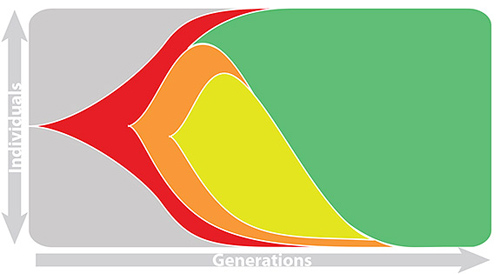
The diagram shows an evolving population of yeast, starting from a single yeast cell at the far left of the diagram in which a genetic mutation occurs (red). As the yeast cell reproduces, the mutation is passed to its descendants over several generations, as shown by the widening red area indicating the increase in the number of individuals with the red mutation. At some point another mutation (orange) occurs in one of the yeast carrying the red mutation. When the yeast cell reproduces, it passes both the red and orange mutations to its offspring. After a few more generations, another mutation occurs (yellow) in one of the red/orange-mutation yeast cells, bringing the total number of mutations that it carries to three (red, orange and yellow). The study shows that multiple (in this case, three) mutations helped the yeast adapt to its environment. In this particular population, another mutation (green) occurred (in yeast that carried the red mutation) that was far more beneficial for the yeast and the individuals with the orange and yellow mutations were forced to extinction while the cells descended from the yeast with the green mutation took over the population. This is one of 40 fully sequenced populations published in this paper that together provide detailed picture of how organisms adapt to their environments. (Image courtesy of Gregory Lang)
